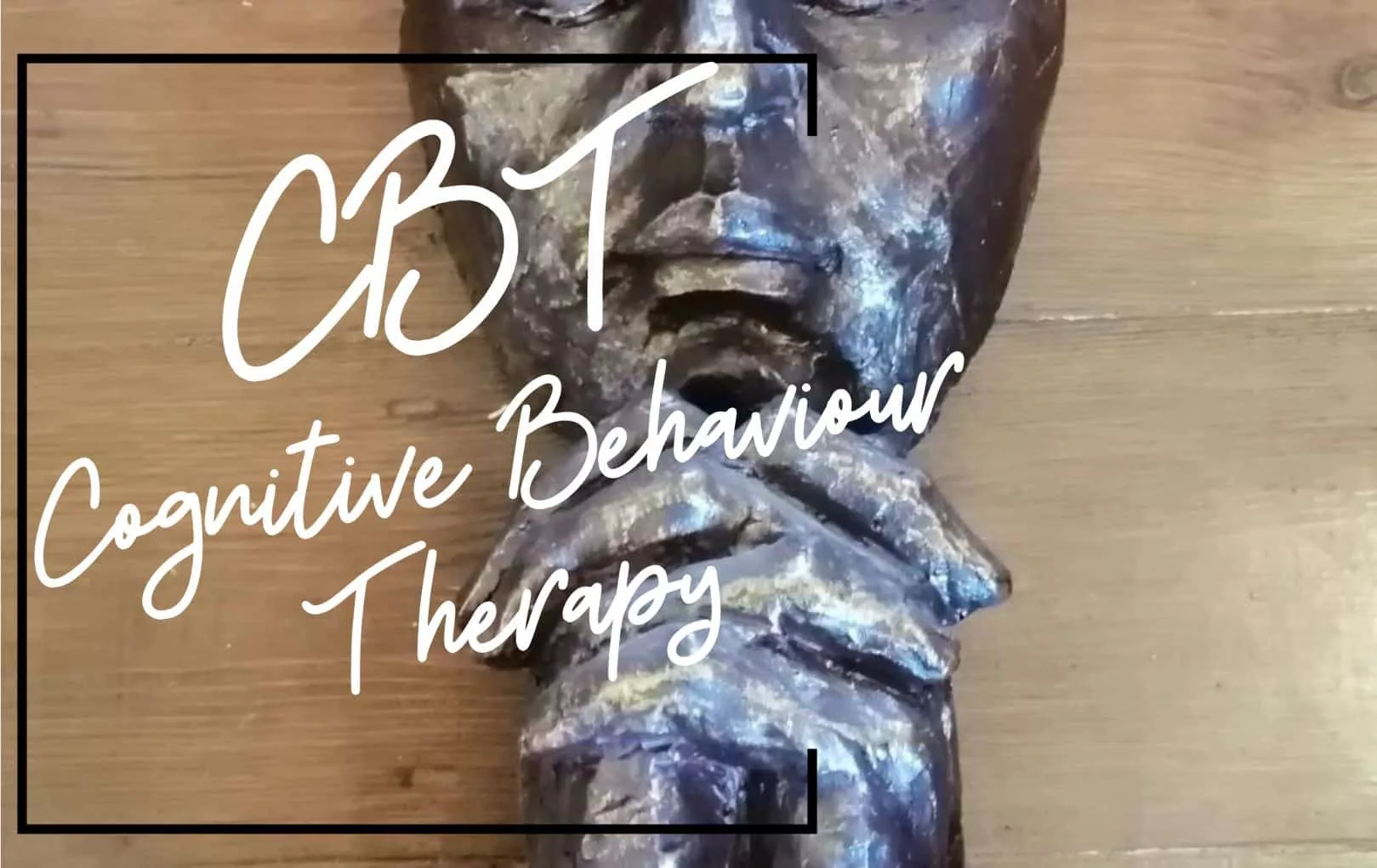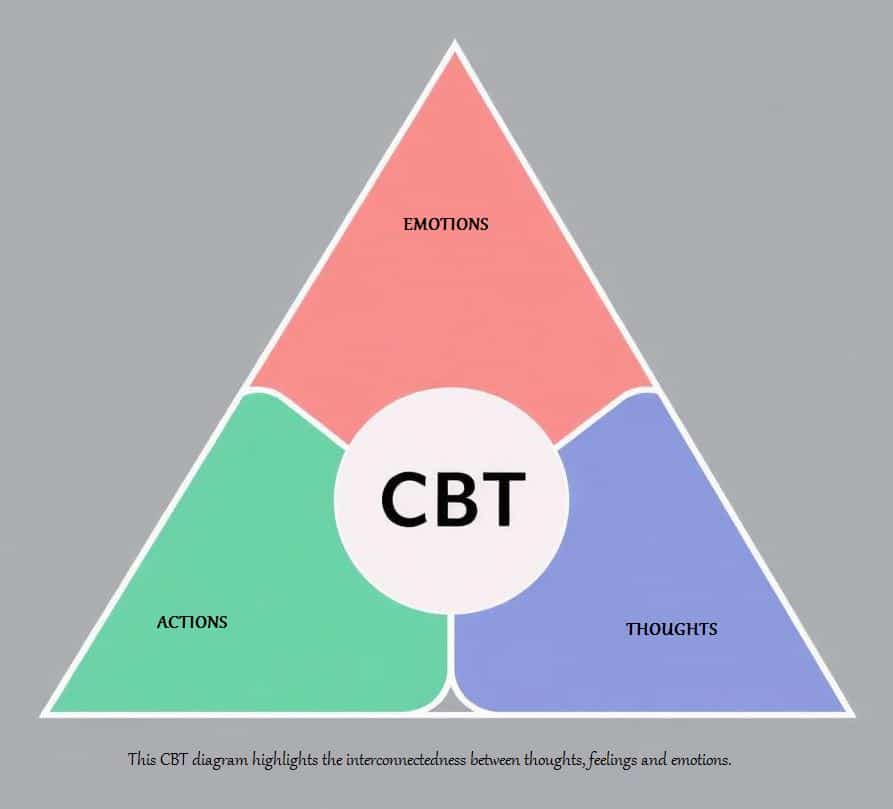
Article written by Anna Keyter (Online Psychologist)
You’ve likely heard the term “CBT” floating around, especially when discussing mental health. But what exactly is Online Cognitive Behavioural Therapy? And why is it considered such a powerful tool in improving mental wellbeing? Let’s dive into the core concepts and modern applications of this widely recognised therapy.
The Foundation of Cognitive Behaviour Therapy (CBT): Thoughts, Feelings, and Behaviours Interconnected
At its heart, Cognitive Behaviour Therapy (CBT) is a talking therapy. It operates on a fundamental principle: our thoughts, emotions, and behaviours are closely linked and constantly influence each other. This interconnectedness is often referred to as Beck’s Cognitive Triad. The idea is simple yet profound. We can find ourselves stuck in a cycle of “unhelpful thoughts and feelings.” These can, in turn, lead to “unhelpful behaviours.” This becomes a perpetuating negative loop. CBT empowers individuals by teaching them that while they can’t always control the world around them, they can learn to control how they interpret things within that world. You can find out more about our online cognitive behaviour therapists. Psychologists use CBT because it is an evidence-based psychotherapy (overwhelming research showing that it works).

Unpacking Your Mind: Automatic Thinking and Cognitive Distortions
While the sources don’t always use these exact phrases, the concepts of automatic thinking and cognitive distortions are central to how Cognitive Behaviour Therapy helps you understand and manage your mind:
- Automatic Thinking (Unhelpful Thoughts): These are the quick, often unconscious thoughts that pop into our heads throughout the day. If these thoughts are consistently “unhelpful” or negative, they can significantly impact our feelings and actions. CBT aims to help you “recognise these unhelpful patterns” in your thinking. For example, the 5-part model in CBT encourages you to conceptualise a specific situation by looking at the interlink between your thoughts, feelings, physical reactions, and behaviours. This helps to shine a light on how your automatic thoughts fit into a broader cycle.
- Cognitive Distortions: These are biased or irrational ways in which our automatic thoughts are often structured, making them “unhelpful” or “negative.” CBT directly addresses these by teaching you to “challenge negative thoughts”. A key technique is the Thought Record. It guides you to “observe the evidence supporting a thought and consider an alternative or balanced thought”. Similarly, the process of “Reframing unhelpful thoughts” involves learning to “step back, examine the evidence for your thoughts and explore other ways of looking at the situation”. This active process helps you identify and modify the distorted thinking patterns that contribute to distress.
How Cognitive Behaviour Therapy Works – Aims and Practical Strategies:
- Cognitive Behaviour Therapy is a patient-guided, goal-oriented therapy. It helps individuals “break down and approach problems in a different way to improve how they feel”. It teaches skills and strategies to develop more effective thinking patterns and coping mechanisms.
Key strategies and techniques used in CBT include:
- Behavioural Activation: This involves encouraging individuals to engage in daily activities that can improve their mood and functioning, combating the tendency to withdraw when feeling low.
- Cognitive Restructuring: This is the process of identifying, challenging, and changing negative or distorted thought patterns. Techniques like the Thought Record are central to this.
- Problem Solving: CBT helps you differentiate between hypothetical worries and real problems that can be tackled with practical solutions, providing strategies to work through them.
- Facing Fears: For conditions like anxiety, CBT guides individuals to gradually confront situations they are afraid of, rather than avoiding them, to ease anxiety and regain control.
- Practical Skills: This includes a range of techniques like breathing exercises, activity scheduling, planning behavioural experiments, creating action plans, and developing distraction techniques.
CBT Delivery: In-Person and the Rise of Online Cognitive Behaviour Therapy
Traditionally, a round of CBT therapy usually consists of 12–15 one-hour sessions with a therapist. However, long waiting times and limited access have spurred the development of Internet-delivered CBT (e-CBT).
e-CBT is a significant development, especially since the COVID-19 pandemic, which accelerated the shift towards digital mental health care. It typically involves 8 to 12 self-contained modules that can be accessed via websites or smartphone applications. Online cognitive behaviour therapy can be used individually or with couples.
Key advantages of e-CBT include:
- Accessibility and Convenience: It is time-flexible and cost-effective, allowing treatment to be delivered from any location with internet access. This is particularly beneficial for those in rural areas or who struggle to leave their homes.
- Reduced Waiting Times: Because it requires less time from trained professionals, online therapy can provide treatment sooner than face-to-face options, addressing issues like waiting lists that can be a year or more.
- Cost-Effectiveness: Studies show online therapy can be significantly cheaper to deliver than face-to-face sessions.
- Patient Empowerment and Privacy: It offers flexibility, accommodates work and childcare commitments, and can be more acceptable to individuals who prefer privacy or anonymity.
- Comparable Efficacy: For conditions like mild-to-moderate Post-Traumatic Stress Disorder (PTSD) and Major Depressive Disorder (MDD), therapist-supported online CBT has shown to be as effective as its face-to-face counterpart, with symptom improvements sustained over time.
However, e-CBT is not without its considerations:
- Not for Everyone: Online approaches are not suitable for everyone, particularly those with complex or severe symptoms, who may still require face-to-face therapy. Research indicates that patients with greater severity of depressive symptoms might prefer in-person therapy when given a choice.
- Importance of Therapist Support: While some self-help e-CBT programs exist, evidence suggests that programs with greater therapist contact are typically more effective and lead to higher completion rates. Therapist guidance helps bridge the gap in direct patient monitoring and helps adapt treatment as needed.
- Technological Barriers: Lack of consistent internet access or digital literacy can limit its availability for some patients.
- Quality and Trust: It’s important to select legitimate programs, which often have government endorsements, affiliations with academic institutions, or support from peer-reviewed literature.
In conclusion, CBT provides a robust framework for understanding and reshaping the intricate connections between our thoughts, feelings, and behaviours. The emergence of online CBT has significantly broadened access to this effective therapy, offering a flexible and cost-efficient solution for many. However, individualised needs and symptom severity remain crucial factors in determining the most appropriate treatment path. If you want to read more about the benefits of online therapy, you can follow this link.
You can also follow this link to learn about DBT.
If you want to learn more about Anna Keyter, the author, you can follow this link.
To get in touch with us, you can complete the form below:
References:
CBT for PTSD: is online CBT as effective as face-to-face therapy? https://evidence.nihr.ac.uk/alert/online-cbt-for-ptsd-is-as-effective-as-face-to-face-therapy/
Nazanin Alavi, Elnaz Moghimi Callum Stephenson et.a. | Comparison of online and in-person cognitive behavioral therapy in individuals diagnosed with major depressive disorder: a non-randomized controlled trial https://www.frontiersin.org/journals/psychiatry/articles/10.3389/fpsyt.2023.1113956/full
David Gratzer, Faiza Khalid-Khan, Internet-delivered cognitive behavioural therapy in the treatment of psychiatric illness – PMC https://pmc.ncbi.nlm.nih.gov/articles/PMC4771536/
Online self-help CBT techniques – Every Mind Matters – NHS https://www.nhs.uk/every-mind-matters/mental-wellbeing-tips/self-help-cbt-techniques/
Hayley Guiney, Alison Mahoney, […], and Richie Poulton+2 Internet-based cognitive behavioural therapy in the real world: Naturalistic use and effectiveness of an evidence-based platform in New Zealand. Sage Journals: Volume 58, Issue 3Discover world-class research: https://journals.sagepub.com/doi/full/10.1177/00048674231183641
Related Posts
Understanding the Difference Between a Psychotherapist and a Psychologist in the UK
When seeking mental health support in the UK, it's important to understand the...
Affordable Online Counselling
Photo by Aleksandrs Karevs What does "affordable online counselling" even...


